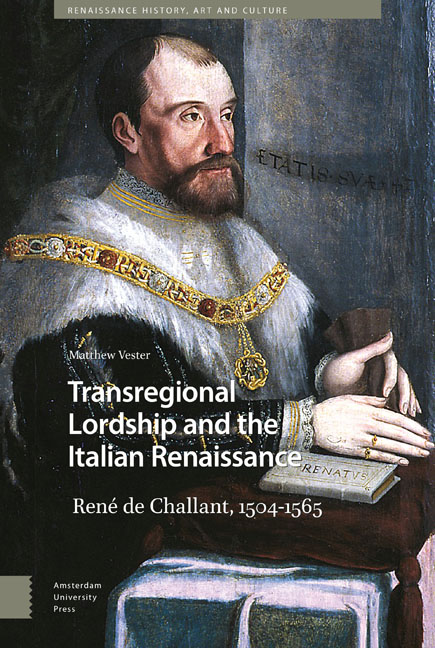Book contents
- Frontmatter
- Contents
- Maps and Tables
- Abbreviations
- Acknowledgments
- 1 On the edge of the Italian Renaissance
- 2 René's early career to 1536
- 3 René's growing influence during the war years, 1536-1553
- 4 René and Duke Emanuel Filibert
- 5 Kinship and noble life
- 6 The Challant political networks
- 7 Finance and brokerage
- 8 Lordship
- 9 The embodiment of spatial politics
- About the author
- Index
2 - René's early career to 1536
Published online by Cambridge University Press: 21 November 2020
- Frontmatter
- Contents
- Maps and Tables
- Abbreviations
- Acknowledgments
- 1 On the edge of the Italian Renaissance
- 2 René's early career to 1536
- 3 René's growing influence during the war years, 1536-1553
- 4 René and Duke Emanuel Filibert
- 5 Kinship and noble life
- 6 The Challant political networks
- 7 Finance and brokerage
- 8 Lordship
- 9 The embodiment of spatial politics
- About the author
- Index
Summary
Abstract
Born in 1504, René de Challant inherited a sprawling array of lands stretching from Lorraine to the Swiss area, Bugey (between Chambéry and Lyon), and the Valle d’Aosta. To these, he added, by marriage, lands in the marquisate of Monferrato. His kinship connections propelled him immediately into the highest ranks of the Sabaudian nobility, and, after his first marriage to the wealthy heiress Bianca Maria Gaspardone ended tragically, he remarried Mencia of Portugal-Braganza, a kinswoman of the Duchess of Savoy and Emperor Charles V. René was named Marshal of Savoie and led Duke Charles III's diplomatic efforts with the Swiss during the early 1530s, aided in this effort by his lordship of Valangin, near Neuchâtel.
Key words: Savoy, Geneva, Swiss, Gaspardone, Mencia
René's early life
The family into which René de Challant was born (c. 1504) had a rich tradition of service to the House of Savoy. René's paternal grandfather, Louis, and father, Philibert, had wielded power on behalf of the dukes in the Valle d’Aosta, Piedmont, and beyond; his mother also received pensions from the Sabaudian rulers. At the age of thirteen, René received his first command, replacing his recently deceased father as castellan of the Valdostano fortress of Bard. The deaths of his paternal grandfather and his mother over the next two years left him isolated, but Duke Charles III (r. 1504-1553) took a personal interest in the young count. In 1518, René was named chevalier of the Annonciade, the knightly order of the Sabaudian dynasty, was given an annual pension of 1200 florins, and was appointed ducal counselor and chambellan. René was advised by his uncle, the cleric Charles de Challant, and his two grandmothers, Guillemette de Vergy and Marguerite de La Chambre. According to an early biographer, the Duke sent René as his envoy to Milan and to Monferrato, where he met Bianca Maria Gaspardone, the recently widowed daughter of a wealthy merchant from Casale Monferrato, who was also the treasurer of the Marquis of Monferrato. They married in 1522. Bianca Maria's dowry included several farms in the Monferrato and five houses in Casale, together worth 25,000 écus.
- Type
- Chapter
- Information
- Transregional Lordship and the Italian RenaissanceRené de Challant, 1504–1565, pp. 53 - 76Publisher: Amsterdam University PressPrint publication year: 2020

